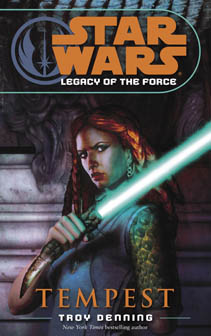The “Legacy of the Force” series is a good collaboration between Aaron Allston, Karen Traviss and Troy Denning, but at the same time, there’s no question that they have different areas of interest. Within the larger context of the Corellia vs. Galactic Alliance civil war, Allston likes to spend more time with X-wing pilots, Traviss with Boba Fett and Mandalorian culture and Denning with fallen Jedi Alema Rar.
That’s all well and good, but Denning’s “Tempest” (2006) – the third of the nine-book series – seems to brazenly shift gears from the point where Traviss left off in “Bloodlines.” On page 377 of that novel, Jacen realizes:
He would have to kill those he most loved. He would have to kill Tenel Ka and his precious daughter, Allana. … Jacen accepted the burden in its entirety, and his heart … broke.
Seemingly, “Tempest” would then feature a more detailed version of Kylo Ren’s “Force Awakens” arc where he decides he must kill his father, Han Solo, to gain dark-side power. But Jacen shifts gears. On page 350 of “Tempest,” he realizes without much internal struggle that:
… he was too afraid of losing his daughter in the middle of a pitched starship battle. … The simple fact was that there were some things he would never sacrifice – not even if it meant saving the galaxy.
Arguably, this is a case of Jacen changing his mind, rather than the authors disagreeing. But if so, it’s rather poorly written because there are no scenes of Jacen going through the process of deciding that Tenel Ka and Allana fall outside the category of people and relationships he’s willing to sacrifice. Further adding fuel to the argument that this is a sloppy retcon is the belief among many fans that “Legacy of the Force” retconned an established point once before. In this series, Jacen and Lumiya regularly refer to Vergere as a Sith, yet “The New Jedi Order” – particularly Matthew Stover’s “Traitor” — went to great pains to show that Vergere did not believe the Jedi-Sith dichotomy was relevant or even real; she believed it all came down to the individual choices of Force users.
While Denning seems to have backed off of an interesting – albeit incredibly dark – idea from Traviss, and the whole saga aims to get back to the classic Jedi-Sith conflict, “Tempest” is not a simple novel from a plot perspective. Taking a side trip from the Corellia-GA conflict, Denning immerses us in a conflict between the Hapes Consortium’s current government (which is allied with the Alliance) and the potential usurpers (who are backed by Corellia).
It’s somewhat difficult to follow all the spying and lies and secrecy, but some good stuff comes out of it, including Han and Leia’s realization that they just can’t win. They were in the right by opposing the GA’s strong-arm tactics, but that put them on the side of Corellia, which in turn was wrong to back the Hapes usurpers to strengthen its own cause.

As is now inevitable with this series, Jacen is hard to read about because he has convinced himself that his special brand of authoritarianism will bring peace – the same conceit of all warmongers throughout history. It would be more interesting if Jacen was truly willing to sacrifice himself; for example, if he made an internal promise to turn himself in for his war crimes (such as murdering Boba Fett’s daughter earlier in the series) after he had achieved his mythical peace. But as it stands, the rationalization of his tactics sound more and more like excuses, even in his internal monologues.
Still, I like the family conflict that spins around the eye of the storm that is Jacen. Luke and Mara struggle with how much freedom to give Ben — who has been serving with Jacen’s black-ops team, the Galactic Alliance Guard — to make his own mistakes. Han, Leia and Jaina deal with the increasingly apparent fact that they’ve lost Jacen to the dark side.
From the plain-old-cool department, “Tempest” gives us the return of Aurra Sing. I had forgotten about this surprise return from my first reading, but quickly caught on by absorbing Denning’s clues, not least of which is the fact that Aurra calls herself Nashtah (a name established in previous stories) and that she has pale skin and a topknot and she wears a tall hat, presumably to hide her antenna. Denning later mentions her long fingers but for some reason doesn’t mention the antenna.
One rather hilarious thing about Aurra Sing is that she is in her 90s in this book, although we’re told she looks much younger. In my head, I picture her as looking basically the same as in prequel-era stories. That’s a bit of a stretch because Aurra is half-human; I guess we have to assume her unknown father was of a long-lived species and that she inherited those genes.
Also, it’s well established in “Star Wars” that human lifespans are different than on Earth. Han is pushing 70 in this novel, but it’s the equivalent of an Earth human nearing age 50. This is a reasonable sci-fi conceit, because the definitions of ages do indeed change as technology improves and people live longer, and generally, the “Star Wars” universe has better tech than Earth. (On the flip side, Tatooine residents seem to age much more quickly than Earth humans, as evidenced by Owen, Beru and Obi-Wan wrinkling under the twin suns.)
In “The Clone Wars” TV series, Aurra was a teacher of Boba Fett, so with these bounty hunters popping up in back-to-back “LOTF” books, it seems a reunion should be in order. Unfortunately, that’s not the case, although in this instance it’s not the fault of a Traviss-Denning disconnect: The TV show aired after this series’ publication, so we didn’t know Sing and Fett had a history together.
Another undeniably cool element is the Lumiya vs. Luke rematch we’ve been waiting for since the Dark Lady’s return to the saga in “Betrayal.” Marvel Issue 96, “Duel with a Dark Lady,” was the first “Star Wars” comic I owned as a kid, and it seems the issue – entirely a fight between Luke and Lumiya, with no plot or characterization beyond that — had an effect on Denning too. In the rematch, Luke (and Mara) again pairs a shoto (a short lightsaber) with his normal lightsaber, as it helps him better contend with Lumiya’s lightwhip, a combination of lightsaber, leather and sharp metal.
Denning effectively sells Lumiya and Alema as a legitimate match for Luke and Mara. In the fight, Lumiya cuts off Luke’s cybernetic hand and he and Mara are lucky to escape alive, especially since the Sith duo are willing to blow themselves and their surroundings sky-high if they are defeated.
Logistically, the war is a mess (and therefore, it’s an accurate portrayal of war, particularly something like the current Middle East quagmire) by the end of “Tempest.” But one thing is certain only three books into the saga: Jacen is beyond redemption. We’re not reading about a fall to the dark side anymore, we’re reading about a dark sider in action. Jacen Force-chokes an underling, taking a strategy directly from the Darth Vader playbook.
Lest there be any doubt among readers, the back page of the paperback asks readers to go online – to the now-defunct darthwho.com — and cast their vote to name this new Sith Lord.

